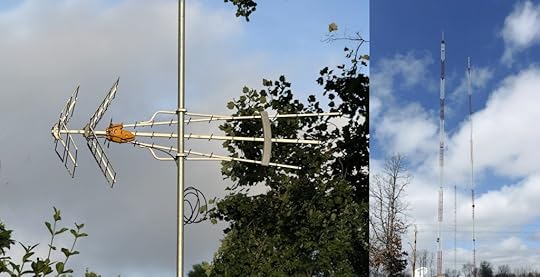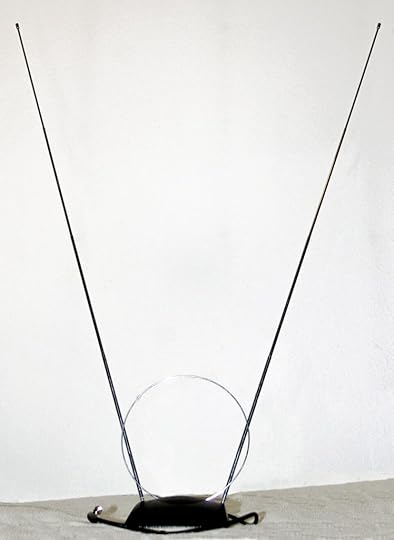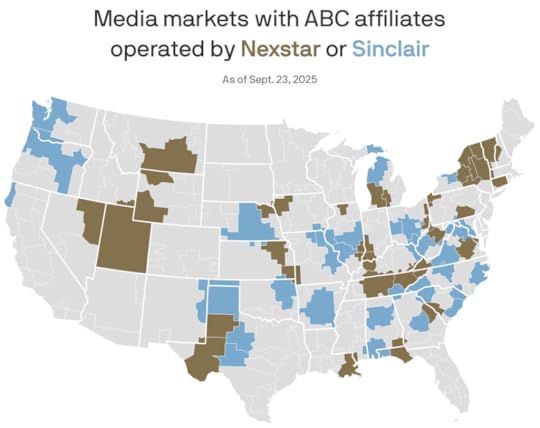The Continuing End of OTA TV
I’ve never watched Jimmy Kimmel Live—or any late-night talk shows since Carson, and I didn’t watch much of him either. But I am familiar with Jimmy, through his Oscars hosting gigs, his friendship with Howard Stern (who I have listened to, for decades), and from YouTube clips when somebody points me to one and I actually go there, which isn’t always.
But I’ll watch tonight, because I’m curious about what Jimmy will say about his hiatus, and because I can get him without cable. I do that this way:
 On the left, the new TV antenna at our new house in Bloomington, Indiana. On the right, the transmitting towers of WRTV/6 and WFYI/20, 54 miles away on the north side of Indianapolis. WRTV is actually on channel 25, and WFYI is on channel 21 (their branded channels are “virtual,” as they say in the biz). Thanks to our antenna, a Telves DAT BOSS MIX LR antenna High-VHF/UHF (Repack Ready)*—that’s its name—we get both channels well, even though their signals are weak at this distance.
On the left, the new TV antenna at our new house in Bloomington, Indiana. On the right, the transmitting towers of WRTV/6 and WFYI/20, 54 miles away on the north side of Indianapolis. WRTV is actually on channel 25, and WFYI is on channel 21 (their branded channels are “virtual,” as they say in the biz). Thanks to our antenna, a Telves DAT BOSS MIX LR antenna High-VHF/UHF (Repack Ready)*—that’s its name—we get both channels well, even though their signals are weak at this distance.Being old, I remember when no suburban house was complete without antenna on the roof. You wanted one because that was the only way you could get a good picture from your city’s TV statoins. Sure, you could put a rabbit-ears antenna like this on top of your TV—

—but the picture probably wouldn’t be ideal, or good on all the available channels.
But cable (which began as CATV—Community Antenna TV) would bring you a good picture on every channel, plus lots of new cable-only channels: dozens or hundreds of them.
Then, starting with the Digital Transition in 2008, all the over-the-air (OTA) stations had to broadcast on channels that were best for data, which meant moving to the UHF band (channels 14 and up), or the “high” VHF channels (7-13). Even if a station was already on one of those channels, it may have had to move, sometimes more than once, as the feds auctioned off the highest UHF channels (now used mostly for cellular Internet) and stations had to “repack” on new channels. That meant viewers had to make their TVs re-scan over and over to get the whole available channel lineup, which tended to come from fewer signals than could be received back in the Analog Age. Thanks to all that, most people didn’t bother to hook up an antenna of any kind.
But I’m a rare exception. Getting OTA TV is like fishing for me. I’ve always been a broadcasting science nerd, and I like hanging out a lure to see what I get. For now, it’s a pile of channels from Indianapolis, plus our nearby PBS station. Yay me.
Back to Jimmy Kimmel.
His network is ABC, carried here by WRTV/6. We’ll be able to get Jimmy tonight, because WRTV is owned by the E. W. Scripps Company. Were WRTV owned by Nexstar, we wouldn’t see the show, because Nexstar won’t carry it on their many stations, for reasons they give here. Sinclair, which also owns many stations, also won’t carry Kimmel, for the same reasons. So, Axios says, all these areas are blacked out:
 Source: Erin Davis/Axios Visuals
Source: Erin Davis/Axios VisualsI’ll let that sit while we visit Nexstar’s plan to buy Tegna, a competing station group company. If that deal goes through, this will be the legacy commercial TV network lineup in Indianapolis:
CBS — WTTV/4 and WTTK/29, owned by NexstarNBC — WTHR/13, owned Nexstar (acquired from Tegna)ABC — WRTV/6, owned by ScrippsFOX — WXIN/59, owned by NexstarMeaning only WRTV would not be owned by Nexstar.
That’s homogenization at work. It is also economics. Legacy (also called “linear”) TV has been in decline for decades. Some links:
Linear TV Networks Lost 35% Of Reach From 2014 To 2024 “…progressive loss of reach for linear TV networks over the last 10 years, with research from MoffattNathanson and Nielsen indicating a 35% decline across all networks from 2014-24.” (The Measure, May 2025)Netflix Leads Streaming Growth in June on the Strength of Multiple Big Titles in Nielsen’s 50th Report of The Gauge “On the whole, broadcast viewing was down 5% to represent 18.5% of total TV, marking the first time the category has fallen below a 20.0% share.” (Nielsen, June 2025)Cord Cutting Statistics 2025 – Market Trends & Latest Data “…estimated that 80.7 million households in the United States will cut the cord by 2026!”(evoca.tv)
“On the whole, broadcast viewing was down 5% to represent 18.5% of total TV, marking the first time the category has fallen below a 20.0% share.” (Nielsen, June 2025)Cord Cutting Statistics 2025 – Market Trends & Latest Data “…estimated that 80.7 million households in the United States will cut the cord by 2026!”(evoca.tv)Over a year ago, in OTA’s future looks shaky despite local live sports’ return, nScreen Media said OTA viewing stood at 13.3%. TVB in July of this year said the number was 16.3%. I doubt both. For sure, the percentage here in Bloomington rounds to zero. I know a lot of people here, and I look at a lot of rooftops to see who has a working antenna. Far as I know, I’m the only viewer in town fishing the TV airwaves. Except for the local PBS station (WTIU/30), nearly all the major network Indianapolis stations (those four above) are too hard to get here without an expensive and fancy antenna such as mine. And I’m advantaged by living on a hill that faces Indianapolis. If you’re between hills or on the backside of one here, even a fancy antenna like mine won’t catch much.
We have a similar situation at our other house, in Santa Barbara. We’re 500 feet up a steep hill overlooking the city, but we are “terrain shadowed” (as the broadcast engineers say) from all the local TV signals. We would get occasional signals from San Diego, when those were still gettable and the weather was right. Here’s how some looked in 2008, when our Dish TV receiver had an over-the-air tuner in it. That’s long gone, and our 4K Samsung TV can’t get any of those channels from the same roof antenna. Not good enough, I guess.
In my experience, the makers of new TVs don’t want you watching free OTA TV. That’s the hint I get from Samsung and TCL. TVs by both make it hard to scan for channels, to put them into a guide, to make them “favorites” or whatever. And when you’re done, they moosh the local channels into a pile of almost countless other channels that look cable-like, but aren’t. In the case of our TCL/Roku TV, locals disappear once you’ve scanned them. It doesn’t matter if they’re your favorites or not.
I suppose this is because the makers want to insert personalized ads of their own (based on watching you, like advertising does on the Internet), and they can’t do that through OTA signals they don’t control.
Far as I can tell, nobody in the broadcast business is urging the TV makers to make getting OTA channels easy. Again, the opposite seems to be the case.
Broadcast TV is, as the econmists say, a distressed asset. That’s bad enough. But hastening the medium’s demise by politically correcting stations—and getting help with that from a censorious FCC—is just dumb all around.
And I’m not saying any of that for political reasons. The station owners and TV makers were no smarter during the Obama and Biden administrations.
For many decades, Local TV was a center that held our civilization together. That the mainstream is drifting into the redstream is beside a much larger point: the choice of TV-like programming on glowing rectangles now rounds to infinite. You can get whatever from whomever and wherever, over the Internet. The best stuff will be subscription-based, mostly. On Demand, as they say. Welcome to now.
So I’ll start up channel 6.1, see what Jimmy has to say, and go to bed. I have more important things to do tomorrow. G’night.
*Here’s the antenna, in case you want to get one. It’s the best.
Doc Searls's Blog
- Doc Searls's profile
- 11 followers



